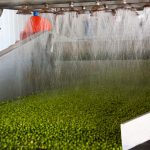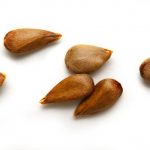
The clementine is one of several citrus species of the mandarin variety. The fruit is also known as the Algerian Tangerine.
It is probably the result of an accidental cross between the Havana mandarin and a bitter or sour orange. The fruit was found in a garden in Algeria in the early twentieth century. The fruit found its way to the USA in 1909.
It has the species name Citrus reticulata Blanco and is a cultivar. It is a member of the mandarin family and is commonly listed as a mandarin when canned. It is not the same fruit however as the Common Mandarin. One of the related tangerines is the Huangyanbendizao tangerine.
US consumers love this fruit. It has a sweet juicy pulp of similar consistency to a tangerine but with greater depth of flavour and no seeds which means it is easier to chew and digest.
Clementines come mostly from Spain.
The fruit is a clean, bright orange and the Spanish fruit in particular has a stronger and deeper flavour than clementines grown in the USA. In 2010, about 150,000 tonnes were exported from Spain to the USA. The growth in the export market for this particular fruit has increased but reached a plateau about 2015.
Processing and Canning
Canned mandarins are closely regulated in terms of quality to avoid wrecking the market for this type of product. Del Monte are one of the largest canners of such fruit. The fruit is usually canned as whole segments and packed in mandarin orange juice or a clarified grape juice made from concentrate. An acidity regulator such as citric acid can be added. The product is usually heat processed to minimise spoilage.
The Oil
Over 70 volatiles are known at least. Most of the studies have been conducted on Italian, Uruguayan and Algerian fruit. The clementine oil has been compared with Wenzhou honey oranges as well as other citrus oils.
Clementine oil has greater amounts of decanal and α-sinensal than related citrus oils. The linalool content is only higher in tangerine oil. These are all major aroma-impact compounds. The amount of linalool varies considerably among the different mandarin varieties. Clementine oil also contains negligible amounts of methyl N-methyl anthranilate; this compound and thymol have been reported as major odorants in mandarin oil which is a distinct difference.
Almost 50 odorants were identified using GC–O, many of which were unsaturated aldehydes with high odour spectrum values (OSV). α‐ and β‐sinensal, trans‐4,5‐epoxy‐(E)‐2‐decanal, (E,Z)‐2,6‐dodecadienal and linalool were found to dominate clementine oil aroma (Chisholm et al., 2003). Using gas chromatography=mass spectrometry (GC-MS) coupled with GC-olfactometry, they discovered a number of new aromas. These were many unsaturated aldehydes, trans‐4,5‐epoxy‐(E)‐2‐decenal, trans‐4,5‐epoxy‐(E)‐2‐dodecenal, 4‐hydroxy‐2,5‐dimethyl‐3(2H)‐furanone (furaneol), 3‐hydroxy‐4,5‐dimethyl‐3(2H)‐furanone (sotolon) and 1,8‐cineole. No one aroma compound characterises a clementine.
References
Chisholm, M. G., Jell, J. A., & Cass Jr, D. M. (2003). Characterization of the major odorants found in the peel oil of Citrus reticulata Blanco cv. Clementine using gas chromatography–olfactometry. Flavour and Fragrance Journal, 18(4), pp. 275-281 (Article)



Leave a Reply